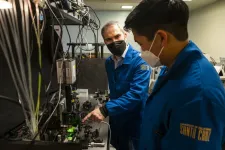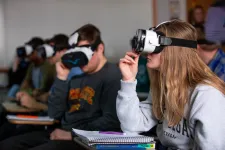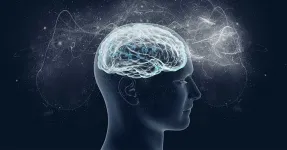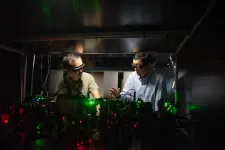(Press-News.org) Sophisticated systems for the detection of biomarkers — molecules such as DNA or proteins that indicate the presence of a disease — are crucial for real-time diagnostic and disease-monitoring devices.
Holger Schmidt, distinguished professor of electrical and computer engineering at UC Santa Cruz, and his group have long been focused on developing unique, highly sensitive devices called optofluidic chips to detect biomarkers.
Schmidt’s graduate student Vahid Ganjalizadeh led an effort to use machine learning to enhance their systems by improving its ability to accurately classify biomarkers. The deep neural network he developed classifies particle signals with 99.8 percent accuracy in real time, on a system that is relatively cheap and portable for point-of-care applications, as shown in a new paper in Nature Scientific Reports.
When taking biomarker detectors into the field or a point-of-care setting such as a health clinic, the signals received by the sensors may not be as high quality as those in a lab or a controlled environment. This may be due to a variety of factors, such as the need to use cheaper chips to bring down costs, or environmental characteristics such as temperature and humidity.
To address the challenges of a weak signal, Schmidt and his team developed a deep neural network that can identify the source of that weak signal with high confidence. The researchers trained the neural network with known training signals, teaching it to recognize potential variations it could see, so that it can recognize patterns and identify new signals with very high accuracy.
First, a parallel cluster wavelet analysis (PCWA) approach designed in Schmidt’s lab detects that a signal is present. Then, the neural network processes the potentially weak or noisy signal, identifying its source. This system works in real time, so users are able to receive results in a fraction of a second.
“It’s all about making the most of possibly low quality signals, and doing that really fast and efficiently,” Schmidt said.
A smaller version of the neural network model can run on portable devices. In the paper, the researchers run the system over a Google Coral Dev board, a relatively cheap edge device for accelerated execution of artificial intelligence algorithms. This means the system also requires less power to execute the processing compared to other techniques.
“Unlike some research that requires running on supercomputers to do high-accuracy detection, we proved that even a compact, portable, relatively cheap device can do the job for us,” Ganjalizadeh said. “It makes it available, feasible, and portable for point-of-care applications.”
The entire system is designed to be used completely locally, meaning the data processing can happen without internet access, unlike other systems that rely on cloud computing. This also provides a data security advantage, because results can be produced without the need to share data with a cloud server provider.
It is also designed to be able to give results on a mobile device, eliminating the need to bring a laptop into the field.
“You can build a more robust system that you could take out to under-resourced or less- developed regions, and it still works,” Schmidt said.
This improved system will work for any other biomarkers Schmidt’s lab’s systems have been used to detect in the past, such as COVID-19, Ebola, flu, and cancer biomarkers. Although they are currently focused on medical applications, the system could potentially be adapted for the detection of any type of signal.
To push the technology further, Schmidt and his lab members plan to add even more dynamic signal processing capabilities to their devices. This will simplify the system and combine the processing techniques needed to detect signals at both low and high concentrations of molecules. The team is also working to bring discrete parts of the setup into the integrated design of the optofluidic chip.
END
Deep neural network provides robust detection of disease biomarkers in real time
2023-05-02
ELSE PRESS RELEASES FROM THIS DATE:
How the brain's dopamine circuitry helps regulate cognitive flexibility and reward-seeking
2023-05-02
The Brain & Behavior Research Foundation (BBRF) is hosting a free webinar, “How the Brain's Dopamine Circuitry Helps Regulate Cognitive Flexibility and Reward-Seeking” on Tuesday, May 9, 2023, at 2:00 pm EST. The presenter will be Nikhil Urs, Ph.D., Assistant Professor of Pharmacology and Therapeutics at the University of Florida and a recipient of a 2018 BBRF Young Investigator Grant. The webinar will be hosted by Jeffrey Borenstein, M.D., President & CEO of the Brain & Behavior Research Foundation, and host of the public television series Healthy Minds.
Register today at BBRFoundation.org
Dopamine ...
AI in medical imaging could magnify health inequities, study finds
2023-05-02
Artificial intelligence (AI) technology in the medical field has the possibility to automate diagnoses, decrease physician workload, and even to bring specialized healthcare to people in rural areas or developing countries. However, with possibility comes potential pitfalls.
Analyzing crowd-sourced sets of data used to create AI algorithms from medical images, University of Maryland School of Medicine (UMSOM) researchers found that most did not include patient demographics. In the study published April 3 in Nature Medicine, the researchers also found that the algorithms did not evaluate for inherent biases either. That means they have ...
Cybersickness more likely to affect women, ongoing research to understand why
2023-05-02
AMES, IA — Iowa State researchers in psychology and engineering found women experience cybersickness with virtual reality headsets more often than men. Their ongoing work, supported by a new $600,000 grant from the National Science Foundation, explores why this difference exists and options to help individuals adapt.
Psychology professor Jonathan Kelly studies human computer interaction, spatial cognition and virtual reality. He says gender discrepancies in cybersickness may not seem that important when it’s related to video games and other forms of entertainment.
"But it’s still a problem, and when VR gets to the point ...
A method to access genetic information in blood samples and find correlations with mental health problems
2023-05-02
Using blood samples to study diseases that originate in the brain is a difficulty faced by psychiatric genetics in the search for markers of mental health disorders. Researchers at the Federal University of São Paulo (UNIFESP) in Brazil have shown that this hindrance can be surmounted by analyzing microRNAs in extracellular vesicles (EVs), which are produced by most cells in the body, including neurons and other nervous system cells.
The study was supported by FAPESP and is reported ...
Air pollution may increase risk of dementia, complicated by genetics
2023-05-02
Three years ago, an international study commissioned by the journal Lancet listed 12 modifiable factors that increased the risk of dementia, including three new ones: excessive alcohol, head injury and air pollution.
Writing in the May 2, 2023 issue of the Journal of Alzheimer’s Disease, a team of researchers, led by scientists at University of California San Diego, further elaborate on how exposure to the last of those new factors — ambient air pollution, such as car exhaust and power plant emissions — is associated with a measurably greater risk of developing dementia over time.
Senior author William S. Kremen, PhD, professor ...
New RNA-seq, metabolomics protocol offers more efficient extraction that maintains data integrity
2023-05-02
GRAND RAPIDS, Mich. (May 2, 2023) — Van Andel Institute scientists have developed a new extraction protocol for RNA-seq and metabolomic analysis, offering a more complete picture of cellular activity than either technique on its own.
The protocol employs a streamlined extraction from a single sample, which reduces variation, improves efficiency, preserves data fidelity and maximizes use of precious biospecimens.
“Our new technique enables researchers to study metabolic phenotypes in a unique way while getting the most information we can out of single samples,” ...
UMass Chan scientists deliver siRNA therapy to lung
2023-05-02
Scientists at UMass Chan Medical School have developed a technology to deliver gene therapy directly to lung tissue through intranasal administration, a development that could potentially create a new class of treatments for lung disease.
Published in The Proceedings of the National Academy of Sciences, the study by a multidisciplinary team of RNA biologists, chemical biologists, immunologists and virologists describes the delivery of siRNA molecules locally to lung tissue. It is the first demonstration that multimeric ...
Forced water-use cuts made California more waterwise
2023-05-02
After a drought-stricken California lifted a year of mandatory water-use cuts that were effective in 2015 and 2016, urban water use crept back up somewhat, but the overall lasting effect was a more waterwise Golden State, a University of California, Riverside, study has found.
Published Tuesday, April 25, in the journal Water Resources Research, the UCR study found that water use by 2019 was still lower than it was in 2013, thanks in large part to water use changes by larger water users.
The water-reduction mandate imposed ...
Quantum entanglement of photons doubles microscope resolution
2023-05-02
Using a “spooky” phenomenon of quantum physics, Caltech researchers have discovered a way to double the resolution of light microscopes.
In a paper appearing in the journal Nature Communications, a team led by Lihong Wang, Bren Professor of Medical Engineering and Electrical Engineering, shows the achievement of a leap forward in microscopy through what is known as quantum entanglement. Quantum entanglement is a phenomenon in which two particles are linked such that the state of one particle is tied ...
TVT 2023 Program Guide Available
2023-05-02
NEW YORK – May 2, 2023 – The program guide for TVT 2023: The Structural Heart Summit is available online. An annual meeting from the Cardiovascular Research Foundation (CRF), TVT features cutting-edge research and techniques for structural heart interventions and will take place June 7-10, 2023, at the Phoenix Convention Center – West in Phoenix, Arizona.
Transcatheter valve therapy has evolved from a novel treatment for the sickest patients to the standard of care for many with aortic stenosis. The rapid adoption of transcatheter mitral and tricuspid therapies has also changed the treatment landscape, expanding options for patients with structural heart disease.
TVT ...






